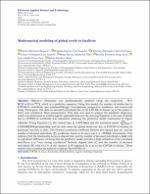| dc.contributor.author | Marín-Machuca, Olegario | |
| dc.contributor.author | Humala-Caycho, Yuri Esquilo | |
| dc.contributor.author | Chinchay-Barragán, Carlos Enrique | |
| dc.contributor.author | Yataco-Velásquez, Luis Andrés | |
| dc.contributor.author | Rojas Rueda, María del Pilar | |
| dc.contributor.author | Bonilla-Ferreyra, Jorge Luis | |
| dc.contributor.author | Perez-Ton, Luis Adolfo | |
| dc.contributor.author | Marín-Sánchez, Obert | |
| dc.date.accessioned | 2025-02-27T22:54:01Z | |
| dc.date.available | 2025-02-27T22:54:01Z | |
| dc.date.issued | 2025-02-26 | |
| dc.identifier.uri | https://hdl.handle.net/20.500.13067/3694 | |
| dc.description.abstract | Objective. Determine was mathematically modeled using the expression𝑁=𝑀(1+𝑄×𝑒−𝑘×𝑡)⁄, which is a predictive equation. Using this model, the number of deaths due to COVID-19 worldwide was estimated.Design. Correlational, prospective, predictive and transversal study. Participans.The data on deceased individuals due to the COVID-19 disease up to November 5, 2022, was considered. Main measurement.This data was used to analyze the pandemic dispersion, which was determined to exhibit logistic sigmoidal behavior. By deriving Equation 3, the rate of deaths due to COVID-19 worldwide was calculated, obtaining the predictive model represented in Figure 3.Results. Using Equation (5), the critical time𝑡𝑐=447𝑑𝑎𝑦𝑠and the maximum speed (𝑑𝑁̂𝑑𝑡)𝑚á𝑥=1525028,553𝑝𝑒𝑟𝑠𝑜𝑛𝑠/𝑑𝑎𝑦and the date when the global death rate due to COVID-19 reached its maximum was July 6, 2021. The Pearson correlation coefficient between the elapsed time (𝑡) and the number of deceased individuals (𝑁) worldwide, based on 33 cases, was𝑟=−0,9365. Conclusions.This indicates that the relationship between elapsed time and the number of deceased individuals is real, with no significant difference, showing that the predictive model provides a high estimation of the correlated data.There is a "very strong correlation" between elapsed time (𝑡)and the number of deceased individuals (𝑁)with 87,7 % of the variance in 𝑁explained by 𝑡, ue to the COVID-19 disease. These models help us predict the behavior of disease like COVID-19. | es_PE |
| dc.format | application/pdf | es_PE |
| dc.language.iso | eng | es_PE |
| dc.publisher | Learning Gate | es_PE |
| dc.rights | info:eu-repo/semantics/openAccess | es_PE |
| dc.rights.uri | https://creativecommons.org/licenses/by/4.0/ | es_PE |
| dc.subject | COVID-19 disease | es_PE |
| dc.subject | Estimation | es_PE |
| dc.subject | Global fatalities | es_PE |
| dc.subject | Logistic modeling | es_PE |
| dc.subject | Validation | es_PE |
| dc.title | Mathematical modeling of global covid-19 fatalities | es_PE |
| dc.type | info:eu-repo/semantics/article | es_PE |
| dc.identifier.journal | Edelweiss Applied Science and Technology | es_PE |
| dc.identifier.doi | https://doi.org/10.55214/25768484.v8i6.3687 | |
| dc.subject.ocde | https://purl.org/pe-repo/ocde/ford#2.02.00 | es_PE |
| dc.publisher.country | PE | es_PE |
| dc.source.volume | 8 | es_PE |
| dc.source.issue | 6 | es_PE |
| dc.source.beginpage | 7782 | es_PE |
| dc.source.endpage | 7790 | es_PE |


